The Fleet Management Console displays Driver, Fleet Asset, Load, Map, and Calendar view information for managing Fleet operations. Four primary functions are completed with the Fleet Management Console. The banner contains a picklist with the options below. This article details the available functions for creating and using Fleet Management Console views. For initial setup information, see the article for the Fleet Management Module.
Fleet Management
Follow the links to Trip Planning, Appointment Setting, and Equipment Management for specific view information.

Zone Logic
Create Zones with the Fleet box Checked to include Zones when managing a Fleet. The movement of Fleet Assets into and out of (inbound/outbound) Zones may be used to filter Fleet Assets. The following record types are located in a particular Zone based on the associated rules.
Appointments
The appointment Account location.
Drivers
Seated Drivers: the current Truck location.
Unseated Drivers: the Driver Domicile.
Equipment (Trailers/Chassis/Containers)
Equipment is attached to a truck: the current Truck location.
Equipment is not attached to a truck: the last Drop Off location.
Fleet Assets (Trucks/Box Truck/Tractors/Power Units)
Fleet Assets not on a Trip Plan or Dispatched on a Load: current Truck location.
Fleet Assets on a Trip Plan: final Planned Truck location.
Loads
Loads not on a Trip Plan: Origin Pickup location.
Loads on a Trip Plan: any Pickup location.
Manage Views
The Fleet Management Console Lightning Web Component is the primary component for performing Fleet activities. It allows for highly customizable views to display relevant Fleet operation information. A Fleet Management Console View consists of a specific type and is associated with filters. The filters on a view contain customizable search criteria to easily find the Drivers, Fleet Assets, Loads, Maps, and Calendars to complete Fleet Management tasks.
Users with the Fleet Management - Read Only setting are not able to interact with the buttons in the top banner.
Create, Clone, Edit, and Delete views to display Fleet information as required.
Select the View Manager button to list, create, view, and manage views.
.jpg)

Manage views with the following icons.
Check the box(es) to select a view or views.
Checked views display in the Fleet Management Console.
Checking or Unchecking views automatically updates and refreshes the Fleet Management Console.
The pencil icon
 edits the existing view.
edits the existing view.The multiple icon
.jpg) clones the view.
clones the view.The X icon
.png) deletes the view.
deletes the view.
Select a Driver, Fleet Asset, or Load record and choose the Chatter icon to open the Chatter feed for that record.

Views may only be created, cloned, edited, or deleted one at a time. Click Save for the current view before continuing to another.
Choose the Refresh button button to update any view changes for all views in the Fleet Management Console.

View the record Detail page for each Driver, Fleet Asset, or Load by clicking the blue link in the Name column.
The following icons allow for managing views.
Check the box(es) to select a view or views.
Checked views display in the Fleet Management Console View Manager.
Checking or Unchecking views automatically updates and refreshes the Fleet Management Console.
The pencil icon
 opens the View Editor to edit the view.
opens the View Editor to edit the view.The multiple icon
.jpg) clones the view.
clones the view.A duplicate view is created
The trash icon
 deletes the view.
deletes the view.
The Database View Query Limit field under TMS Admin → Configuration controls the number of query results for views. The default value is 1,000. Reduce the field value to increase performance when querying records in Fleet Management Console views.
Create
Choose type of view and select the New button to open the View Editor and create a new view.
.jpg)
Enter the following information in the View Editor to create the new view.
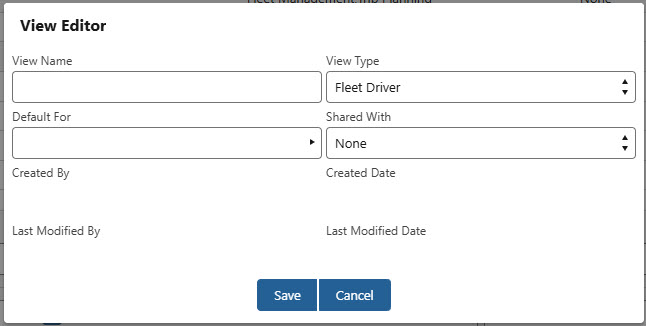
View Name
Enter a name for the view.
View Type
Select the type of view to create.
Fleet Driver
Fleet Asset
Fleet Load
Fleet Map
Fleet Calendar
Note that certain views are limited to particular Fleet Management functions. See the table below for the available view types.
Default For
Select Fleet Management, Trip Planning, Appointment Setting, and/or Equipment Management to set when the view is the default.
Shared With
Select the Group(s) to share the view.
Views may only be shared with Users that are added to the Public Group directly. The Group Member Type must be User. Sharing by any of the following selections does not share the View.
Roles
Roles and Internal Subordinates
Roles, Internal and Portal Subordinates”
Public Groups
Use caution when sharing views. A user may only view columns and fields in a view when they have the appropriate object and field permissions.
Click Save when finished creating the view.
The following view types are available for each of the following Fleet Management functions.
Fleet Management | Trip Planning | Appointment Setting | Equipment Management |
|---|---|---|---|
Fleet Driver | Fleet Driver | Appointment Setting | Fleet Equipment |
Fleet Asset | Fleet Asset | Fleet Map | |
Fleet Load | Fleet Load | Fleet Calendar | |
Fleet Map | Fleet Map | ||
Fleet Calendar | Fleet Calendar |
View Editor
Edit existing views with the View Editor.

Open the editor by clicking the pencil![]() icon to edit an existing view.
icon to edit an existing view.
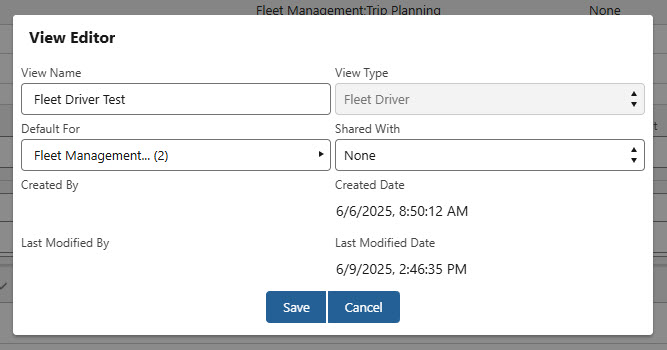
Change the View Name, Default For, or Shared With fields as necessary and click Save.
The Shared With field is a Public Group. Add users individually to the group. Selecting groups of users does not share views. See Salesforce documentation for more information on creating Public Groups. If a Fleet Management view is not shared with a Public Group, it is a private view.
Once views are created, Check the box(es) in the View Manager to display the desired views.
View Controls
Control each view with the following icons.
The Header
 icon expands and collapses the view to show or hide header filter fields.
icon expands and collapses the view to show or hide header filter fields.The Grid
.jpg) icon expands and collapses the grid section to show or hide records that meet filter criteria.
icon expands and collapses the grid section to show or hide records that meet filter criteria.Open the View Editor with the Edit
 icon.
icon.Check
 Include Header Criteria to save all filter data in the view header.
Include Header Criteria to save all filter data in the view header.Check
 Include Grid Filter criteria to save all of the following settings.
Include Grid Filter criteria to save all of the following settings.Saves all grid column sort criteria.
Saves all grid column selection and order criteria.
Saves all column logic filters.
Saves column sizing.
Saves the number of rows in the view.
Column value filters are not saved.
The Sort
 icon allows for sorting the grid column order.
icon allows for sorting the grid column order.Configure columns with the Grid Column Selection
 icon.
icon.Click the Reorder
 icon to adjust the order of the views.
icon to adjust the order of the views.Move views up and down in the list as necessary and click Save.
The X
 icon removes the view.
icon removes the view.The remove action does not delete the view.
The Clone
.jpg) icon creates a copy of the current view.
icon creates a copy of the current view.The Refresh
 icon refreshes the current view grid data.
icon refreshes the current view grid data.
Use the Save and Refresh buttons when updating the filter criteria for views. Records that meet or do not meet updated filter criteria are loaded after saving and/or refreshing.
Grid Filtering
Grid Column Selector
Customize the field columns for managing records in the grid view. Add field(s) to the Columns column to control view fields in the grid view. Custom fields are supported in the Fleet Management Console grid filtering.
The example image below contains the options to sort the grid records for Fleet Assets.
Click the Grid Column Selector
.jpg) button to open the Grid Column Selector for a view.
button to open the Grid Column Selector for a view.Search object fields for desired fields.
The object available is set by the type of view.
Add or remove derived fields to the Columns column.
Add derived fields to the Columns column by clicking the + icon.
Derived fields included as columns are noted with the checkmark
 icon.
icon.Remove derived fields from the Columns column with the — icon.
Derived fields are queries and are not stored as object fields.
Add fields from the Fields section to include them in the Columns list. Fields included as columns are noted with the checkmark
 icon.
icon.Add fields to the Columns column by clicking the + icon.
Move fields up or down in the Columns column by clicking the field and dragging it up or down the list.
Remove fields from the Columns column with the — icon.
When removed, fields no longer appear as columns for records in the grid.
Close the Column Selector View modal with the X icon.
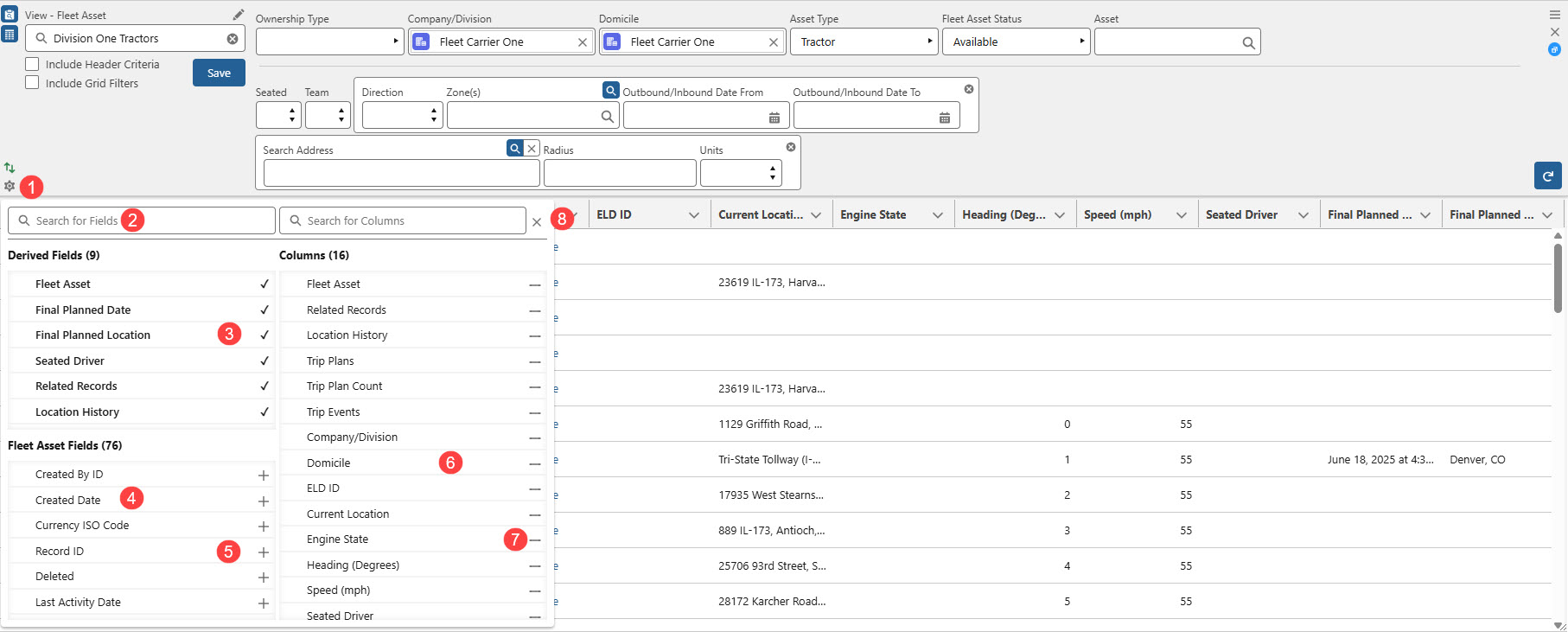
The number of columns that can display in a view depends on the columns selected. Views with too many columns do not save. It is recommended to have fewer than 35 columns.
Grid Column Sorting
Customize the fields that control the sorting of records in the grid view. Add field(s) to the Order By column to control the sorting of fields in the grid view. Fields added to the Order By column do not appear in the grid view.
The example image below contains the options to sort the grid records for Fleet Assets.
Click the Sort
.jpg) button to open the Grid Column Sort for a view.
button to open the Grid Column Sort for a view.Search object fields for desired fields.
The object available is set by the type of view.
Add derived fields to the Order By column.
Derived fields are queries and are not stored as object fields.
Add fields from the Fields section to include them in the Order By list. Fields included for sorting are noted with the checkmark
 icon.
icon.Add sorting fields to the Order By column by clicking the + icon.
The arrow icons determine whether the column is sorted in ascending order (up arrow) or descending order (down arrow) based on that field.
The list of fields determines the order that records are sorted in the grid.
Move fields up or down in the Order By column by clicking the field and dragging it up or down the list.
Remove fields from the Order By column with the — icon.
When removed, fields no longer determine the sort order for records in the grid.
Close the column sort modal with the X icon.
.jpg)
Column Options
Each column in the grid contains additional features for viewing and filtering records.

Click and drag the line between columns to resize the column.
The grid may be expanded to increase the number of visible rows. Click and drag the resize
 icon in the bottom right corner of the grid.
icon in the bottom right corner of the grid.
Select the down arrow to expand the view for each column in the grid.
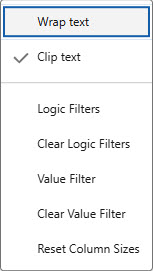
The following filter actions are available.
Wrap Text
Column widths adjust to fit text.
Clip Text
Column widths are static and hide longer column names.
Logic Filters
Add filters to each column to further refine searching for records.
Setting a filter automatically refreshes the records displayed in the grid.
Active filters appear with a blue and white icon.
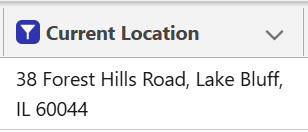
Logic filters may have one or two criteria.
Add a second filter with the + icon.
Select either AND or OR to determine the logic.
Remove the second filter with the — icon.
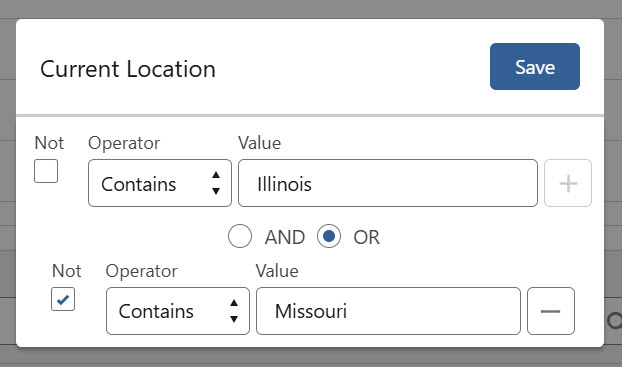
Clear Logic Filters
Removes the logic filter.
Value Filter
Create a list of records found in the column. Select records as necessary to view them in the grid.
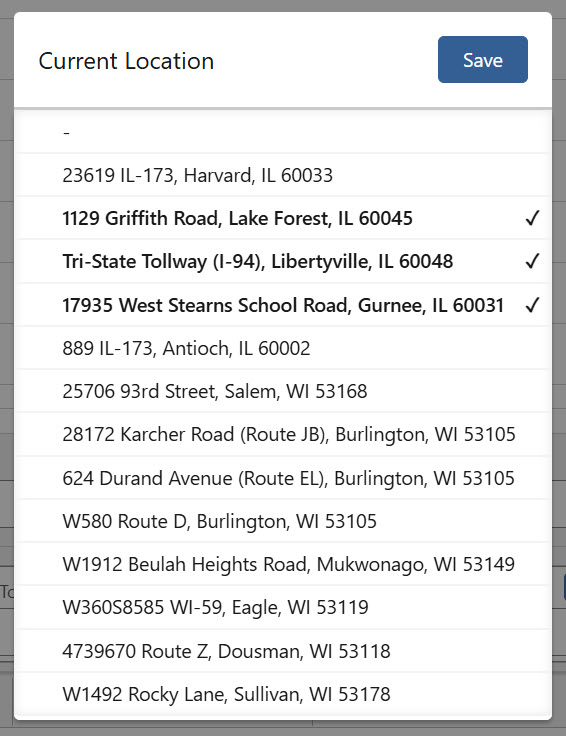
Clear Value Filter
Removes the set value filter.
Reset Column Sizes
Returns the column to the default settings.
See Salesforce information for column filtering for each operator type. All column filters are case-insensitive.
Value In (The Value In operator acts as a multi-select Equals operator that provides the ability to return all record values that match the filter(s).)
Clone
Click the multiple.jpg) icon to clone an existing view. Cloned views have the “- Cloned” suffix added to the View Name. Edit the cloned view as necessary.
icon to clone an existing view. Cloned views have the “- Cloned” suffix added to the View Name. Edit the cloned view as necessary.

Delete
Click the ![]() icon to delete an existing view.
icon to delete an existing view.
Fleet Management Functions
Fleet Management actions are completed by selecting the banner icons for the record or records from each view. Each icon opens a modal or component to complete a specific task.
.jpg)
Click the box on the left to select all records in the view. When multiple records are selected, Uncheck the box to un-select all of the records in the view.
The Related Records
 icon opens the Fleet Related Records component that displays Trip Plan Related records for the view type.
icon opens the Fleet Related Records component that displays Trip Plan Related records for the view type. Add fields for each object to the appropriate Field Sets to view additional field information when viewing this component.
Each Related Record supports the Chatter feature for more efficient communication.
.jpg)
The Location History
 icon opens the Fleet Location History component. The component displays the location and movement history for a Driver, Fleet Asset, or Load. Driver locations update when seated in a Fleet Asset (Tractor/Power Unit/etc.).
icon opens the Fleet Location History component. The component displays the location and movement history for a Driver, Fleet Asset, or Load. Driver locations update when seated in a Fleet Asset (Tractor/Power Unit/etc.).Location and movement history is displayed for the previous 24 hours. Select a value less than 48 hours from the drop-down to view more precise location information.
The location history for the selected record is displayed on the map. Choose a location with the radio button. A chosen location appears on the map as a green dot.
The Duration (Minutes) column shows the time between the position update and the time change. If a Fleet Asset is not moving, the location does not change. The time is monitored by the TMS.
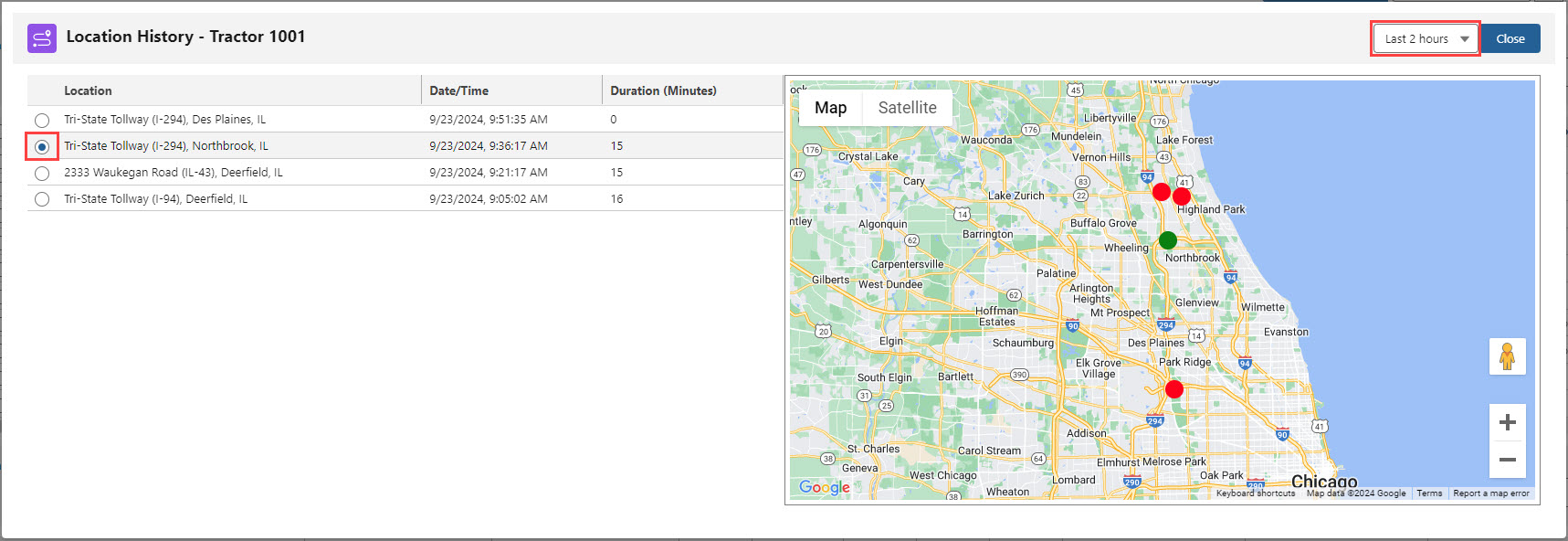
Click Close to return to the Fleet Management Console.
The Trip Plans
 icon opens either the Fleet Trip Planner component or the Fleet Trip Plan List component.
icon opens either the Fleet Trip Planner component or the Fleet Trip Plan List component.The Fleet Trip Planner LWC opens for any Drivers, Fleet Assets, or Loads with 0 or 1 associated Trip Plan. See Trip Planning documentation for more information.

The Fleet Trip Plan List LWC displays the associated Trip Plans for the record. To view the Fleet Trip Plan List LWC, a Driver, Fleet Asset, or Load must be associated with 2 or more Trip Plans.

The Active Trip Plan Count
 /
/ column displays the number of Trip Plans that occur within the filtered date.
column displays the number of Trip Plans that occur within the filtered date.
The Trip Events
 icon opens the Fleet Trip Event Viewer component. If there is an Alert associated with the Driver, Fleet Asset, or Load, the bell icon changes to the
icon opens the Fleet Trip Event Viewer component. If there is an Alert associated with the Driver, Fleet Asset, or Load, the bell icon changes to the lightning bolt icon. When all Alerts associated with a Driver, Fleet Asset, or Load, the icon returns to the Trip Events bell icon.
lightning bolt icon. When all Alerts associated with a Driver, Fleet Asset, or Load, the icon returns to the Trip Events bell icon.Trip Events must have the Is Alert field Checked to change the Console icon. All Events with the Is Alert field Checked must be resolved to change back to the bell icon.
Click the Add button to manually create a Trip Event record.

Trip Events are also populated automatically or by Trimble Maps when the integration is enabled.
Select the Trip Event radio button to view the record details for that Trip Event.
The Trip Plan Status field is set to Load Changed and outlined in yellow.

Enter Event Details and/or the Chatter feed and describe the actions taken. Save the Event when finished.
The Is Addressed field is set to Checked.
When the Trip Event is addressed, the Trip Plan Status field is set to Configured.
See Trip Planning for information on manually creating Trip Event records. It is recommended to create Trip Events from the Trip Plan record directly and not through the Trip Events icon in a view.
Driver Views
Driver views provide a list of the Drivers for managing Fleet operations. Filter Driver records with the following header fields.
.jpg)
Driver Type
Endorsements
Driver Status
Domicile
Team
No value returns all results.
Company/Division
Manager
A lookup to the User record.
Driver
A lookup to the Driver record.
This filter type is exclusive. No other filters may be used when searching by Driver.
Seated
No value returns all results.
Further refine searches for Drivers with grouped header filters. The filters listed follow the criteria below.

Zone Search
Drivers are displayed based on the following matching criteria.
Inbound/Outbound Zone Search
Based on the Direction and Date Range
Driver
Inbound
Based on the first Trip Plan Segment end location.
Trip Plan Legs of Segments containing one of the Drivers with an End Date within the Date Range.
Outbound
Based on the last Trip Plan Segment end location.
Trip Plan Legs of Segments containing one of the Drivers with a Start Date within the Date Range.
No Direction
The geolocation of the Power Unit on Trip Plan Segments containing one of the Drivers within the Date Range.
Zone
Select one or multiple Zones.
Outbound/Inbound Date From
Outbound/Inbound Date To
Address Search
Radius Search
Driver Confirmation
Confirm Drivers for a Trip Plan Segment on the Trip Planner LWC. See Trip Planning for more information.
Driver records must have a Confirmation Method of Email to receive Fleet Driver Confirmation emails.
The Driver Activation Status field is tied to the Driver Status field. Driver’s with an Activation Status of Available must also have a Status of Available to display (when filters allow) in Driver views on the Fleet Management Console.
Driver’s with a Deactivated Activation Status do not display in Driver views.
Driver’s with a Status of Unavailable do not display in Driver views.
Send Fleet Messages
Messages may be sent to Driver(s) from the Fleet Management module.
.jpg)
Check each Driver to send a message.
Click the Send Driver Message button.
Enter the message to send the Driver(s).
Click the Send button.
Outbound messages to drivers are sent immediately when the Send button is clicked.
The Catena or Samsara credentials card must be enabled to enable the message functionality.
Fleet Asset Views
Fleet Asset views show the Tractors/Power Units that fulfill the filter requirements for a given view.
.jpg)
Fleet Asset views follow the logic below. Select the appropriate criteria to view Fleet Assets.
Ownership Type
The Ownership Type filter allows for filtering Fleet Assets based on the Asset Ownership Type field value.
Add Fleet Asset Asset Ownership and Asset Ownership Type field values to search and order records that may not be company owned. Sort based on the following ownership types.
Company Owned
Owner Operator
Agent
Company/Division
Domicile
Asset Type
Fleet Asset Status
Asset
This filter type is exclusive. No other filters may be used when searching by Asset.
Seated
No value returns all results.
Team
No value returns all results.
Further refine searches for Fleet Assets with grouped header filters. The filters listed follow the criteria below.

Zones
Fleet Assets are displayed based on the following matching criteria.
Inbound/Outbound Zone Search
Direction
Fleet Asset searches are based on Direction and Date Range.
Inbound
Based on the first Trip Plan Segment end location.
Trip Plan Legs of Segments that contain one of the Fleet Assets with an End Date within the Date Range.
Outbound
Based on the last Trip Plan Segment end location.
Trip Plan Legs of Segments that contain one of the Fleet Assets with a Start Date within the Date Range.
No Direction
Fleet Asset geolocation.
Zone
Select one or multiple Zones.
Outbound/Inbound Date From
Outbound/Inbound Date To
Radius Search
Inbound and outbound matches for Fleet Assets (Truck/Tractor/Power Unit/etc.) are determined by the final Trip Plan date and location.
Inbound and outbound matches for Fleet Assets that are not trucks (equipment, etc.) are determined by the final Trip Plan date and location of the associated truck.
Load Views
Create Load views based on the criteria added to header filters. As Loads are assigned to and dispatched on Trip Plans, they filter onto and off of the views created. Use the header filters to search for Loads.

The following filters are located in the header to narrow Load record results.
Mode
Singular search.
Temperature Controlled
No value returns all results.
HazMat
No value returns all results.
Fleet
No value returns all results.
Add the Fleet field to the Load TMS1 field set to include it on the Load Configuration LWC.
Load Status
Fleet Load Status
Team
Customer
This filter type is exclusive. No other filters may be used when searching by customer.
Load
This filter type is exclusive. No other filters may be used when searching by Load.
EDI
No value returns all results.
Inbound and outbound zone matches for Loads are determined by the final Stop location.
Further refine searches for Loads with grouped header filters. The filters listed follow the criteria below.
.jpg)
Stops
Stop Location
A lookup to the Stop Account.
Stop Type
No value returns all results.
Date Ranges
Outbound Date From
Enter a date for single date matching.
May be combined with Inbound Date From/To ranges.
Outbound Date To
May be paired with Outbound Date From to search a range.
Inbound Date From
Enter a date for single date matching.
May be combined with Outbound Date From/To ranges.
Inbound Date To
May be paired with Inbound Date From to search a range.
Match criteria for Date ranges are based on the following Inbound/Outbound criteria.
Non-Trip Plan Loads
Outbound based on the Load origin.
Inbound based on the final Load destination.
Trip Plan Loads
Outbound based on the first Trip Plan Segment Leg end type.
Inbound based on the final Trip Plan Segment end location.
Zones

Direction
No value returns all results.
Zone(s)
Lanes
Search a Lane by entering an Origin and Destination with a radius and unit of measurement.

Origin Address, Destination Address
Search only an Origin, a Destination, or both.
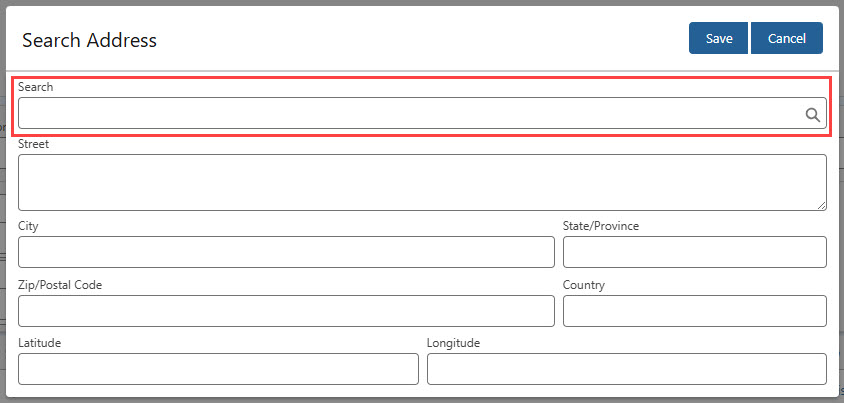
The Origin city is the Load Shipper Account.
The Destination city is the Load final Stop Account.
The Search field uses Google search to find an address.
The Street, City, State/Province, Zip/Postal Code, Country search uses PC Miler to find an address.
Enter latitude and longitude coordinates to search for specific geolocations.
Radius
Units
Detail View
Use the Load Detail View mode by selecting the Detail View Mode  button in the Fleet Load view header.
button in the Fleet Load view header.

Check each Load to view the Detail Mode for those Loads as shown in the screenshot below. When one Load is selected, the view splits the screen to display the Detail view section to the right.
Click the dropdown arrows in the Detail Mode view to display the Stops for the selected Load.
View the Line Item information for a Stop by choosing the dropdown arrow for that Stop.
Add field columns in the detail view with Load, Stop, and Line Item field sets. Fields add to the Load TMS39 field set that contain a timezone are based on the user’s browser timezone. (For example, the Last Location Update Sent field.)

The Detail View is only available for Fleet Load views. Detail Views for Trip Plans will be available in a future release.
Appointment Views
Appointment views provide a list of the Appointments by Zone, by Location, and/or Appointment Status. See more Appointment Setting information here.
Locations must be included in a Trip Plan to appear in the Appointment view filtering.
Create an Appointment view by selecting Appointment Setting from the Fleet Management Console header. From the View Manager header, choose Fleet Appointment and click New.

Enter a View Name, if necessary select Appointment Setting under Default For, and any groups under Shared With.
Click Save to finish creating the view.
Adjust header filter fields as necessary based on the logic below.
Choose the appropriate Appointment Status(es) for the selected view.
Unmade
Requested
Confirmed
The Lead Time fields for Appointment Start and End are determined by the current date.
A Lead Time of 1 day is the day following the current date.
A Lead time of 15 days is 15 days from the day after the current date.
Use negative numbers to find missing appointments in the past.
-10 searches the past 10 days to find appointments that are not set.
Search for Location(s) in the view header to add them to the list of locations to create appointments.
Search for a Zone to view the locations available within that Zone.
.jpg)
Equipment Management Views
Equipment Management views allow for managing Trailers, Chassis, Containers, and Pool information. Select Equipment Management from the banner picklist and create Equipment Pool views as needed.
Equipment Management contains two grid headers.
Equipment Management Header
The grid contains the Equipment Pool location information.
Equipment Management Detail Header
The grid contains the Fleet Assets located within the Equipment Pool.
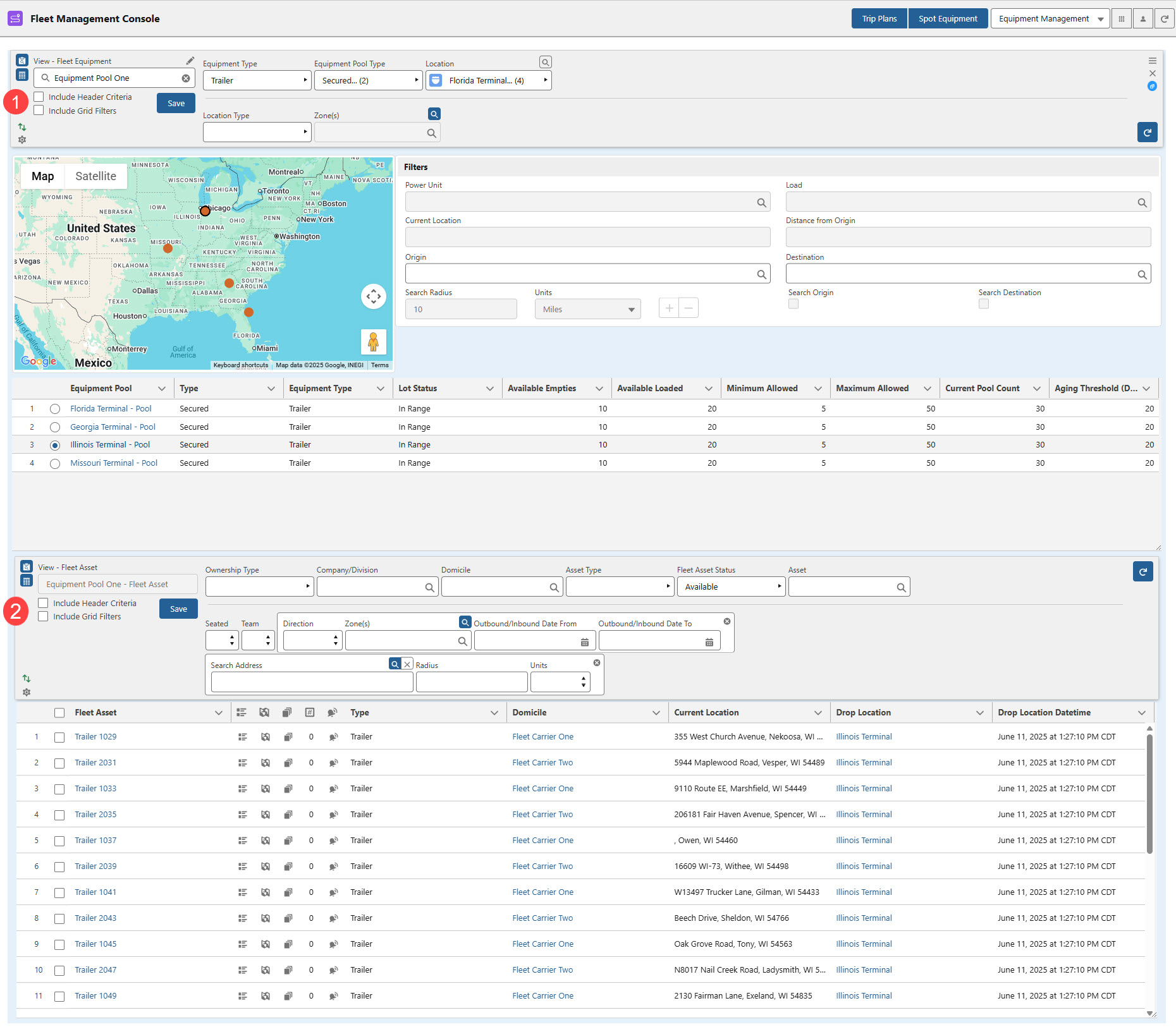
Equipment views include a map with terminal locations. Filter by Power Unit, Load, Location, and distance. Choose the appropriate selections for Equipment Type, Equipment Pool Type, Location, Location Type ,and/or Zone(s) to view Fleet records that meet the criteria.
The following rules determine the location of a Fleet Asset for Location, Zone, and Inbound/Outbound view searching and filtering.
Location
Fleet Assets that are hooked to a Power Unit/Tractor update their location based on the Power Unit/Tractor location.
The Fleet Asset geolocation updates as the Power Unit/Tractor geolocation updates.
Fleet Assets that are dropped at an Account location such as an Equipment Pool.
The Fleet Asset geolocation updates to the Account location.
If a Trailer or Container has an ELD device, the geolocation is updated based on the ELD information.
If a Trailer or Container does not have a tracking device, the geolocation updates with the Power Unit/Tractor location.
Fleet Assets that are not hooked to a Power Unit/Tractor, the geolocation is the current Account location.
Fleet Assets hat are not hooked to a Power Unit/Tractor and not located at an Account location are located at the last geolocation.
A reverse address lookup provides the current address from the geolocation.
Click a Terminal location on the map or select the radio for a location from the list. The location address is provided when clicked on the map.
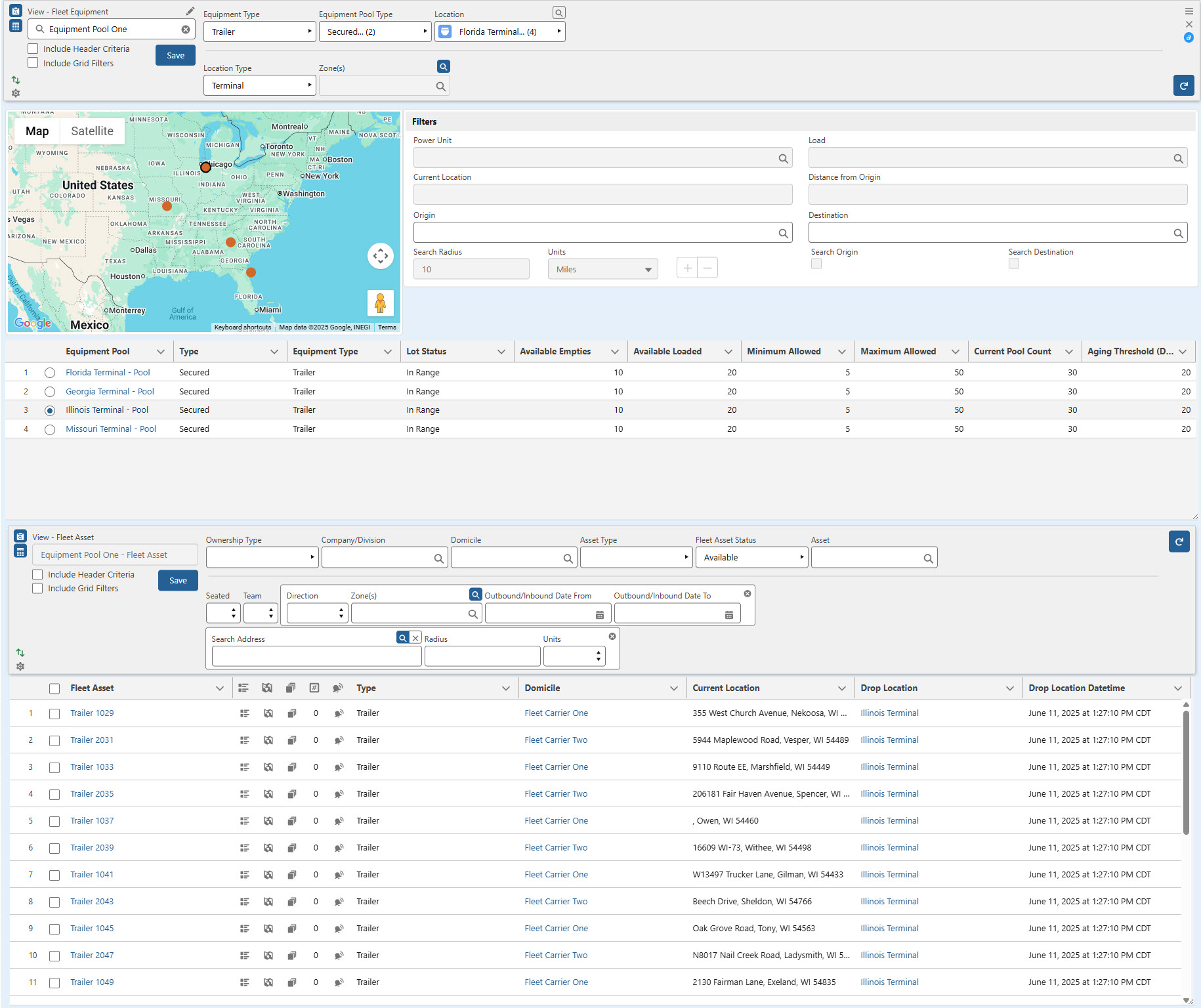
Search by Origin or Destination (when Checked), by Account location, and by Fleet Asset in the particular grid section.
Filter available Fleet Assets in the Equipment Manager Detail section for the selected location with the following fields.

Ownership Type
Company/Division
Domicile
Asset Type
Fleet Asset Status
Asset
This filter type is exclusive. No other filters may be used when searching by Asset.
Seated
No value returns all results.
Team
No value returns all results.
The Equipment Manager Detail header contains additional grouped filters. The search filters function as described below. Select the criteria to filter the available equipment displayed in the grid.

Inbound/Outbound Zone Search
Direction
Fleet Asset Dispatched
Inbound
Based on the first Trip Plan Segment end location.
Outbound
Based on the last Trip Plan Segment end location.
Fleet Asset not Dispatched
Current Fleet Asset location.
Zone
Select one or multiple Zones.
Outbound/Inbound Date From
Outbound/Inbound Date To
Radius Search
Use the Refresh icon when updating the search and filter criteria to view the Fleet Assets that meet the criteria.
See Equipment Management for more information.
Map
Map view functions below are available when Fleet Management, Trip Planning, or Equipment Management is selected from the picklist on the top banner.
The Fleet Management Console map displays Drivers, Fleet Assets, and Loads based on the specific views and filters selected.

Check Drivers, Fleet Assets (Tractors), and Loads from multiple views to locate them on the map. As records are selected, the map automatically updates and zooms to display the most recent location of each record.
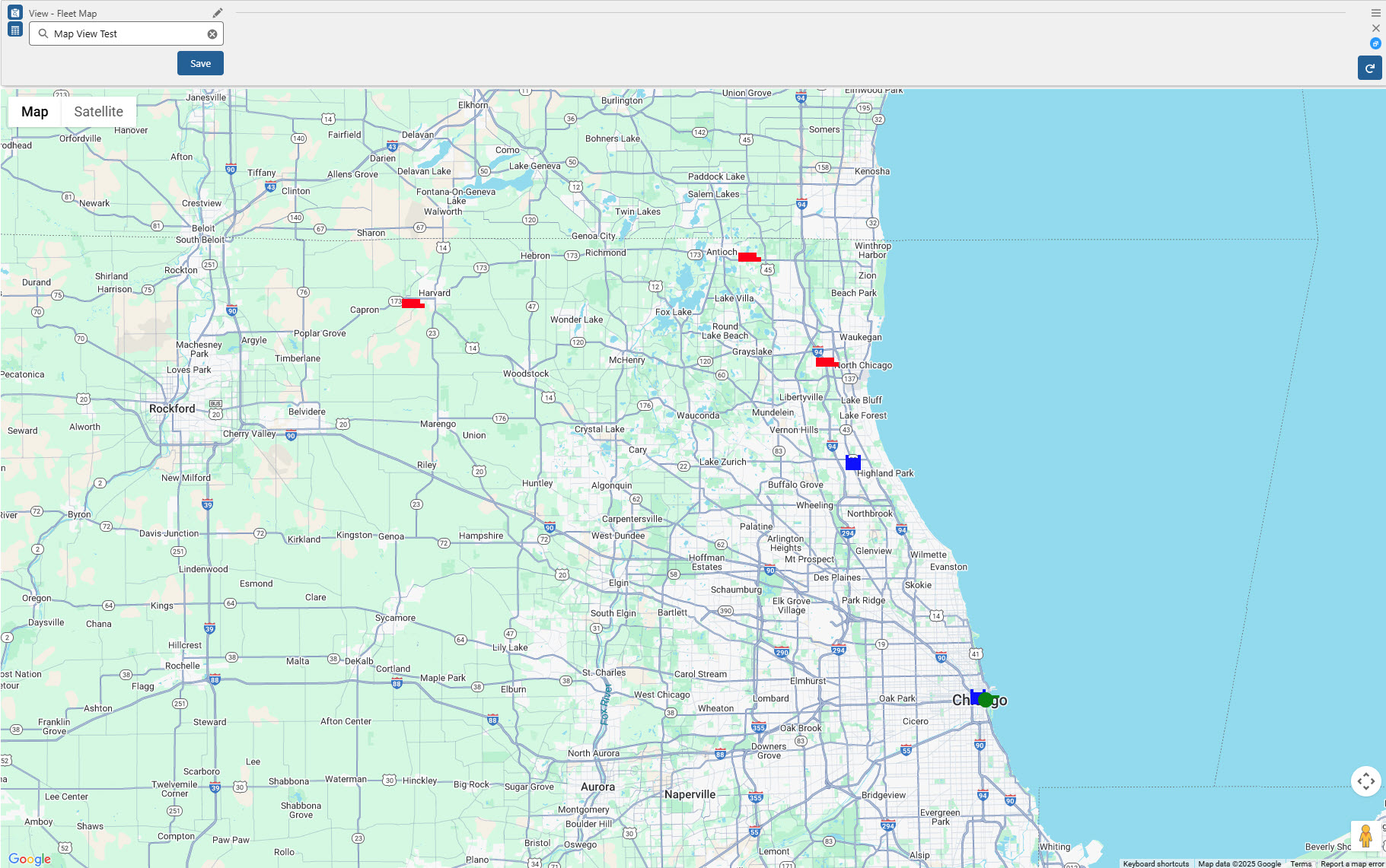
Drivers appear on the map with a green icon.
Fleet Assets (Tractors) appear on the map with a red icon.
Loads appear on the map with a blue icon.
Click each Driver, Fleet Asset, or Load to view additional record information. When a record is selected on the map to display details, any additional records are Unchecked.
Calendar
Select a Calendar tab to view the availability of Drivers, Fleet Assets, and Loads.
Check the appropriate Drivers, Fleet Assets, and Loads from available views to display on the calendar.
Drivers and Fleet Assets associated with a Trip Plan appear on the Calendar in shades of green.
Loads not associated with a Trip Plan appear in the calendar in blue. Once a Load is associated with a Trip Plan, the Load appears in green. The following criteria control how Loads appear in the Calendar.
Loads without Expected Dates for the Stops do not appear in the calendar.
The starting date on the calendar is the Expected Date for the first Stop. The starting time is the Appointment Time of the Expected Date for the first Stop.
If no Appointment Time is set for the first Stop, 12:01 a.m. is used for the calendar time.
The ending date on the calendar is the Expected Date for the last Stop. The ending time is the Appointment Time of the Expected Date for the last Stop.
If no Appointment Time is set for the last Stop, 11:59 p.m. is used for the calendar time.
Click the green bar for a Load to open and view the associated Trip Plan.
Loads may span across multiple Trip Plan Segments. Each Trip Plan Segment is separated by a divider(s), but the Load appears as one continuous bar.
Other Calendar Entries are displayed in shades of gray.
From the Calendar view header, choose a Timezone, Start Date, a Number of Days, and the Hour Grouping size to filter time period.
.jpg)
Click the + button to add a Calendar Entry for a Driver or Fleet Asset. Additional Calendar Entries stack vertically when dates and times overlap for a single Driver or Fleet Asset.

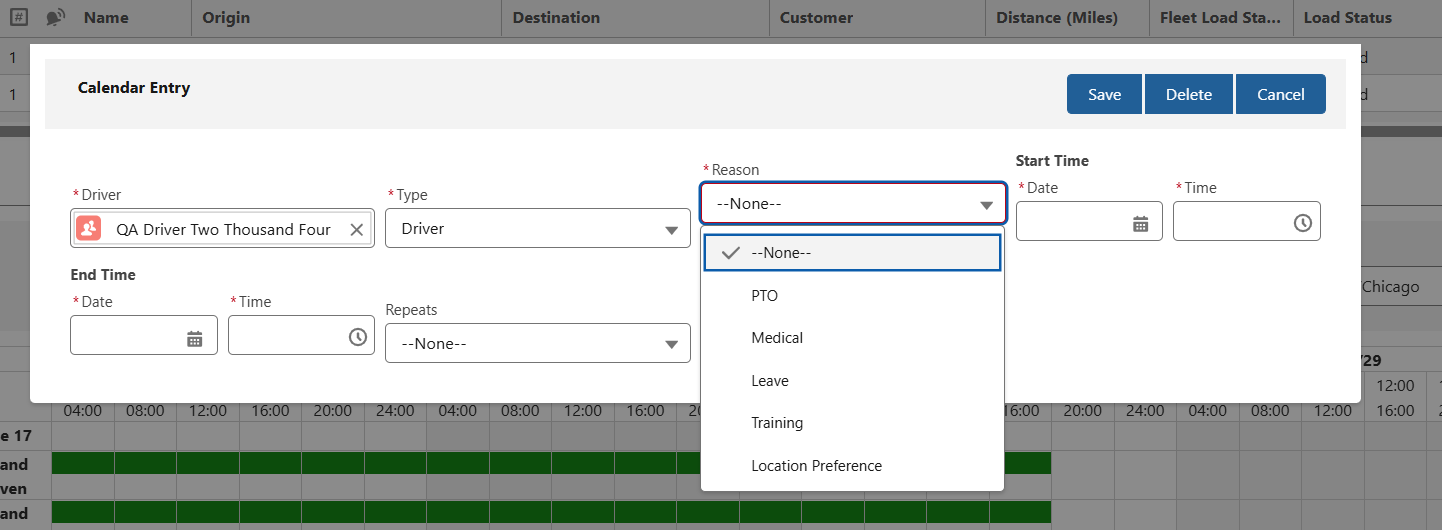
Loads cannot be created from the calendar in the Fleet Management Console.
Hover over a Trip Plan or Calendar entry to view additional information.

Driver and Fleet Asset detail pages also contain specific entries on the Calendar tab. Fleet Calendar Entries may be added from the record detail page on the related list.
The Fleet Load Status must be Configured on the Trip Planner for Trip Plan calendar entries to populate on Drivers or Fleet Asset records.

Driver Assignment
Driver Assignments refer to long-term pairing or “seating” of a Driver to a Fleet Asset (a Tractor or Power Unit), typically in the case of an owner-operator. Creating Trip Plans and adding a Driver or Fleet Asset that is a component of a Driver Assignment adds both records to the Trip Plan.
Select a Fleet Asset (Tractor) and click the Driver Assignment button to open the Fleet Driver Assignment Lightning Web Component. This LWC displays existing Driver Assignment records and allows users to create, modify, or delete existing Driver Assignments. If multiple Fleet Assets are Checked when clicking the Driver Assignment button, the Driver(s) are only assigned to the first Fleet Asset.
Driver records must be created first before creating Driver Assignments. See additional information for creating Drivers here.
.jpg)
One or Two Drivers may be assigned to a single Fleet Asset (Tractor).
Driver records with a populated Co-Driver field are considered a Team. Assigning the Driver to a Fleet Asset assigns both Drivers. The Driver Type column displays Team instead of Solo.

Driver Assignments continue indefinitely if no End Date is provided.

Drivers may be removed from a Driver Assignment with the Unassign  button or the Delete
button or the Delete  button.
button.
If a Driver is assigned to another Fleet Asset, the TMS automatically unassigns the Driver from the existing Assignment. The Driver is then assigned to the Fleet Asset of the new Driver Assignment.
When Unassigning a Driver Team, both drivers must be Unassigned from the Fleet Asset.
Historical Driver Assignments are listed for the Fleet Asset.

Driver Assignment records are available on the Driver and Fleet Asset records. Always edit and delete Driver Assignments from the Fleet Driver Assignment LWC and not any of the related lists on the records.